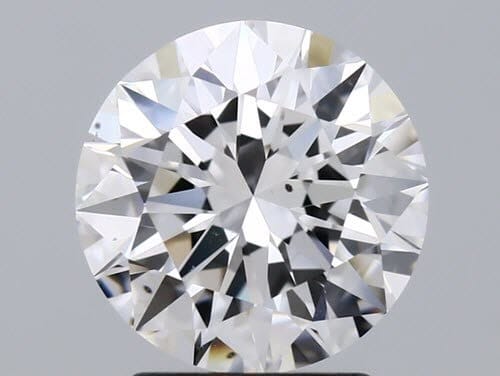Why you shouldn’t buy based on certification only?
A lot of my customers put great emphasis on the diamond grading report or certificate. I fully understand and appreciate that. By far the most popular and most trusted name in the diamond grading industry is the Gemological Institute of America (GIA). With online-sales at an all-time high many people are buying simply based on a GIA certificate through one of the many online-sales websites. But there are many mistakes that can be made. And you can easily end up with a lesser quality diamond than you thought. I will address the problems of buying online in a separate blog entry. Here I want to focus on the clarity issue alone.
Is VS2 graded diamond always better than SI1?
Letters and numbers on a certificate alone can’t give you a full understanding of a diamond’s clarity. They can even be misleading. As the example below shows, all other grades equal, an SI1 can be a cleaner and better diamond than a VS2. Even when you examine the plotting on a diamond grading report you can still not know whether an inclusion is visible or not, black or white, on the surface or deep inside the stone. In order to fully appreciate the clarity of a diamond you have to look at it in person. And there you will see that some SI1s are cleaner than VS2s, cost less, and are better diamonds. Let me explain…
VS stands for VERY SLIGHTLY included. GIA defines that “Inclusions are minor and range from difficult to somewhat easy for a skilled grader to see under 10 x magnification”. The working definition for VS also says that inclusions are not visible to the naked eye. However, this is not always true, even for diamonds that have a certificate from GIA.
SI stands for SLIGHTLY INCLUDED. GIA defines that “Inclusions are noticeable to a skilled grader under 10x magnification”. Again, the working definition says that inclusions are hard to locate by the naked eye and easily visible under magnification. The truth is, however, after seeing thousands of diamonds and certificates that these definitions don’t hold up to the reality of diamond clarity. In fact, an SI1 clarity diamond can be 100% eye-clean and even under magnification it can be difficult to locate the imperfections. And for quite a few VS2 clarity diamonds it is rather easy to see the black crystals through the loupe and even to the naked eye the diamond is not 100% clean.
Let me give you an example:
Here you see an SI1 graded diamond that has no visible imperfections. The center of the diamond is completely free of any noticeable inclusions and the minor inclusions that exist on the outside of the stone are not visible to the naked eye. Below the SI1 you see a VS2 graded diamond. You would expect this diamond to be at least as clean if not cleaner than the SI1 above. The truth is, however, that the VS2 diamond has a black inclusion on the table that is visible to the naked eye. Both diamonds have GIA certificates. Which one would you spend your money on?

Excellent SI1 GIA#1225926219

Bad VS2 GIA#2258762197
Do Not Buy Diamond Before You See It
My conclusion for you as a customer is: don’t buy based on a piece of paper. You don’t know what you are buying until you see it. So why not come and see the diamonds such as engagement rings first? I have a large selection of diamonds in almost any category you want. You can check them out in my office, compare them side by side, inspect them through a microscope or the diamond loupe, weigh them, and wear them on a sample ring and so on. Enjoy a hands-on diamond buying experience where you know what you get, rather than solely buying off a computer screen where you can have a bad surprise.



